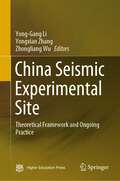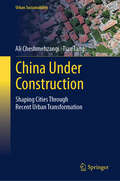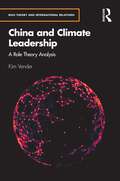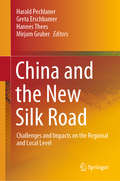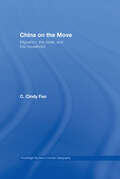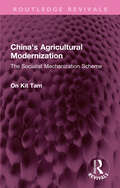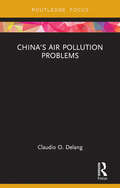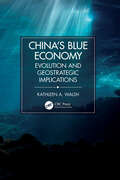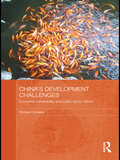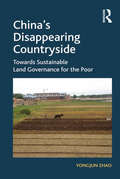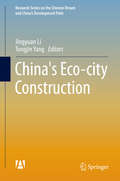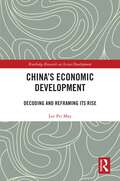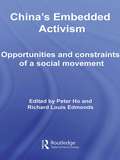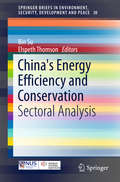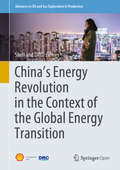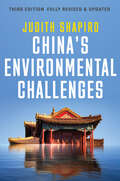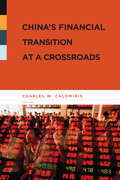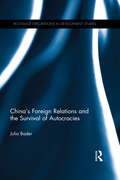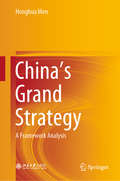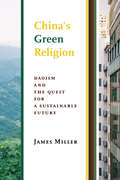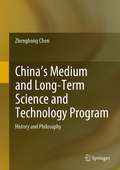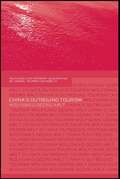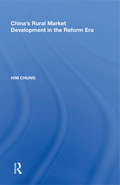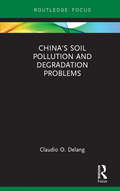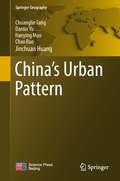- Table View
- List View
China Seismic Experimental Site: Theoretical Framework and Ongoing Practice
by Zhongliang Wu Yongxian Zhang Yong-Gang LiThis book introduces an integrated conceptual framework of the China Seismic Experimental Site (CSES), describes its scientific challenges and research priorities, and reports preliminary results coming out of observational infrastructure in seismology, tectonophysics, geodesy, geophysics and geochemistry. Preliminary community fault model, community velocity model, and community strain rate model in the CSES are described in this book. A multidisciplinary test observation system includes GNSS, seismic array, and deep drilling system under construct around middle segment of the Xiansuihe-Xiaojiang fault and other seismogenic faults in the CSES which are also introduced. This book introduces multidisciplinary topics and a wide spectrum of solid earth system to describe various disciplines, methods, and techniques through the CSES. This book presents a vision of the CSES that is dedicated to deepen the scientific understanding of continental earthquake preparation and occurrence and enhance the disaster resilience of the society. It aims at establishing a field laboratory of earthquake science, in which international and interdisciplinary cooperation could be fostered and supported. Contents of this book include the following:• History of Seismic Experiment Sites in the World.• Launching of CSES Project: Seismicity, Existed Earthquake Monitoring Networks, and Historical Seismic Disasters.• Seismotectonics and Geodynamics of the Eastern Margin of the Tibetan Plateau with Implication for the CSES.• Theoretical Framework of CSES in View of Natural Science and in view of Social Science.• Updated Earthquake Monitoring Network in China.• CSES Community Models of Geology, Structure, and Deformation.• Earthquake Forecasting Models.• CSES Products: Massive Data Procession and Distribution.• A Review of the Field Expedition of the June 17, 2019, Changning, Sichuan, M6.0 Earthquake.• Rupture Structure and Earthquake Risk of the South Longmenshan Fault Viewed by Guided Waves.• Seismic Risk Assessment.• Model of a Seismic Experimental Site with Application to the Comparative Study between CSES and ASES.
China Under Construction: Shaping Cities Through Recent Urban Transformation (Urban Sustainability)
by Ali Cheshmehzangi Tian TangAs a continuation of our award-winning book, ‘China's City Cluster Development in the Race to Carbon Neutrality’ and our recent book, ‘30 Years of Urban Change in China’s 10 Core Cities’, this book delves into China's recent progress in reshaping its cities through holistic urban transformation strategies. Building on our previous work, we expand our focus to explore the latest developments in urbanization, examining how recent strategies and policies have influenced cities and cityscapes across China and beyond. It is evident that China is reshaping its cities through a dynamic interplay of policy reforms, technological advancements, and creative planning. The late 20th and early 21st centuries have seen a sharp increase in urbanization, with a particular focus on the development of smart, resilient, and sustainable cities. Through a thorough examination of case study examples that have undergone significant recent change, this book investigates how these goals are being achieved. ‘China Under Construction: Shaping Cities through Recent Urban Transformation’ offers a thorough overview of China's current urban transformation efforts, highlighting both the achievements and the ongoing challenges, through case studies and in-depth evaluations. We hope to provide insightful information about the real-world applications of urban strategies and their wider implications for China's future urban landscape by concentrating on ten selected cities. This extension of our earlier research emphasizes how critical it is to view urban transformation as a complex process influencing social dynamics, technology, infrastructure, and environmental sustainability, among other facets of city life and urbanization.
China and Climate Leadership: A Role Theory Analysis (Role Theory and International Relations)
by Kim VenderIn this book, Kim Vender examines China’s leadership in climate change governance. International climate change negotiations were supposed to achieve an agreement at two summits: in 2009 in Copenhagen and again in 2015 in Paris. China’s part in the negotiations has elicited a narrative of ‘obstructor’ first and ‘climate leader’ later. Vender challenges this view of China and investigates why it is still persisting today despite a steady leadership recognition of China found by a long-term survey of negotiation participants.In its design, the book explores China’s relationship with the main narrators of the story, i.e., powerful industrialised countries, but also with so far under-explored to both scrutinise China’s performance in the climate change negotiations and show how socialisation and the political context have shaped China’s relationship with others. The book furthermore illuminates Chinese understandings of China’s role in climate change as well as contestation of, and support for, an international climate leadership role at home.China and Climate Leadership offers an in-depth exploration of China’s behaviour and motivations, and contributes to the ongoing debate on China’s rise and integration into international society. It will be of interest to both academics and practitioners with an interest in International Relations, role theory and Foreign Policy Analysis, China, and climate change governance.
China and the New Silk Road: Challenges and Impacts on the Regional and Local Level
by Harald Pechlaner Greta Erschbamer Hannes Thees Mirjam GruberThis book studies the Chinese “Belt and Road Initiative” (BRI), also called "New Silk Road", and focuses on its regional and local effects. Written by experts from various fields, it presents a range of case studies on the geopolitical, socio-economic, ecological and cultural implications of the BRI for European regions and their stakeholders. The book is divided into four parts, the first of which discusses the history of and China’s motivations for the BRI. The second part explores the global phenomenon from a number of regional standpoints. In turn, the third part presents studies on the political, socio-economic, cultural and ecological implications of the New Silk Road project. The final part highlights the tourism prospects in connection with the Silk Road project, as tourism has established itself as an important economic sector in many regions along the historic Silk Road. This book will appeal to scholars of economics, international relations and tourism, decision-makers, managers, chambers of commerce and entrepreneurs with special interests in establishing collaboration with the Chinese market.
China on the Move: Migration, the State, and the Household (Routledge Studies in Human Geography)
by C. Cindy FanChina on the Move offers a new and more thorough explanation of migration, which integrates knowledge from geography, population studies, sociology and politics; to help us understand the processes of social, political, and economic change associated with powerful migration streams so essential to Chinese development. Using a large body of research, clear and attractive illustrations (maps, tables, and charts) of findings based on census, survey and field data, and selected qualitative material such as migrants’ narratives, this book provides an updated, systematic, empirically rich, multifaceted and lively analysis of migration in China.
China's Agricultural Modernization: The Socialist Mechanization Scheme (Routledge Revivals)
by On Kit TamOriginally published in 1985, this study investigates the actual experience in mechanization during the Fourth Five Year Plan period, a period which represented, in many ways, a new stage in China’s rural development. It examines the historical perspective and the development approach under which mechanization efforts were exerted during this 5-year period and the mechanism, outcomes and problems these entailed. The book addresses the issues involved in agricultural development and mechanization through a more integral analysis of the way technological transformation has been linked to China’s quest for social and economic development.
China's Air Pollution Problems
by Claudio O. DelangChina’s rapid industrialisation has led to "an air pollution catastrophe". Concerted efforts to achieve economic growth have led to veiled skies of toxic air and created health and morbidity problems as well as tremendous environmental degradation. China’s Air Pollution Problems provides an overview of air pollution in China describing how and why China has ended up in such a dire situation, what the government is doing to address the problem and the difficulties it is encountering in attempting to reduce the pollution. The analysis is based on both grey literature (newspaper articles, NGO reports, Chinese government information) and on academic studies. The grey literature gives a voice to those who suffer from the pollution, their advocates, and government officers, and allows the reader to better grasp the conditions on the ground, and the impact of air pollution among people in different areas in China. The academic literature adds a theoretical perspective and brings these different case studies into a broader context. This book will be of great interest to students of environmental pollution and contemporary Chinese studies looking for an introduction to the topic and also for researchers looking for an extensive list of sources and analysis of China's environmental problems.
China's Blue Economy: Evolution and Geostrategic Implications
by Kathleen A. WalshThe United States and China are each actively pursuing development of a Blue Economy to promote greater marine, maritime, and naval capabilities through more innovative, sustainable and environmentally friendly means. This book examines China’s approach to developing a Blue Economy, compares China’s efforts to developments in the United States, analyses prospects for cooperation, and competition, and outlines strategic implications arising from China’s linkage of the Blue Economy development concept to its Maritime Silk Road initiative. An understanding of the Blue Economy as it is being pursued in China and the Indo-Pacific region is extremely relevant for academics, industry professionals, and government officials.Features Describes in detail the development of the Blue Economy concept in China over time Includes geostrategic analysis based on the author's extensive research and explains the implications of China's Blue Economy strategy for the Indo-Pacific region Discusses timely and important topics of interest to government, industry, and academic experts, both present and future Adds value to the studies, interdisciplinary collaborations, and expertise on a complex issue of strategic, technological, and economic concern Clarifies the linkages among Blue Economy, environmental and sustainable development and recognizes the importance of understanding the Blue Economy concept at a global scale This book is written for everyone interested in Blue Economy studies, those who study and practice international relations, environmental policy and development, marine policy and governance, maritime and naval strategy, international and Asian affairs, as well as Indo-Pacific security matters.
China's Development Challenges: Economic Vulnerability and Public Sector Reform (Routledge Studies on the Chinese Economy)
by Richard SchiereThis book argues that a major potential source of social tension in transition and developing countries is not poverty as such, but vulnerability: that is, the risk of becoming poor. It demonstrates how in China many of the recent reforms to the public sector, such as decentralisation from central to local government, especially fiscal decentralisation; the reduction in public services provided by the state; the increasing practice of local government of charging fees for basic services which were previously free; de-collectivisation of the rural commune system and market sector experimentation in Economic Processing Zones have made many households extremely vulnerable to poverty. Having to find funds to pay for health and education leaves the households exposed should macro-economic fluctuations related to factors – such as trade, resource imports, and financial volatility – have an adverse impact on the Chinese economy overall. The book argues that to become less vulnerable to macroeconomic shocks China would need to shift from an export-oriented development strategy to a domestic consumer-demand driven development strategy, and this would need to be supported by public sector reforms: strengthening of public service provisions in the health and the education sectors as well as expanding social security programs. The book discusses these problems, relates them to the economic literature and outlines the likely consequences.
China's Disappearing Countryside: Towards Sustainable Land Governance for the Poor
by Yongjun ZhaoWhile China’s hybrid rural land tenure system has contributed to agricultural development, it is interwoven with rising farmland loss and social conflicts.This book examines the linkages between land tenure, development and governance in the context of China’s development transformation. Drawing on empirical studies, it advocates the exploration of innovative land tenure systems that address the wider determinants: institutions, power, politics and social development. It argues that a land tenure system can only be sustainable when it is compatible with the overall biophysical, social, political and economic conditions. This new institutional lens into the conditions and dynamics of land tenure systems marks a paradigm shift away from those focusing on the narrow meaning of land rights and tenure security strengthening, as these approaches can paradoxically contribute to weaker land and resource governance. Contributing to an enhanced understanding of the challenges China faces in agricultural development and natural resource governance and to the international debates on land tenure reform, this book will be of interest to researchers, practitioners, policy-makers and students in development studies, anthropology, sociology, political sciences, law, geography, economics, public administration and other relevant disciplines. The lessons learnt from China also shed light on its global engagement on sustainable development and governance issues.
China's Eco-city Construction (Research Series on the Chinese Dream and China’s Development Path)
by Jingyuan Li Tongjin YangThis book introduces the concept of Eco-civilization, highlights the construction and development of eco-cities in China, and assesses the achievements and shortcomings of China's eco-city construction projects. As both China and Western countries face an impending ecological crisis, responding to that crisis is a common challenge for all human beings. There is an overwhelming consensus among Chinese scholars that in order to successfully address the ecological crisis successfully we must establish an eco-civilization, and one important step toward accomplishing that goal is to plan and construct eco-cities.
China's Economic Development: Decoding and Reframing its Rise (Routledge Research on Asian Development)
by Lee Pei MayThrough a rigorous examination of “China’s rise”, Lee addresses an important question—Did China catch up? Or more specifically, can growth be automatically translated to catching up with the advanced industrialised countries or has it only allowed limited progress (if any) to be made?To answer these queries and the broader question of the possibility of the Global South converging with the Global North, four development theories are utilised, with competing explanations, to uncover the complexity and multifaceted development of China. This includes whether China really has a unique developmental model to offer. Positioning China within the global economy, this book traces its developmental progress over time as well as its progress relative to other countries. To understand whether the Chinese political economy is socialist (or not), Lee moves away from the orthodox definition of socialism and instead examines the official narrative of Socialism with Chinese Characteristics. Lastly, this book argues that though China is catching up, challenges that could potentially block China’s progress for a full catch‑up are to be anticipated.A useful resource for students and scholars in the fields of international relations, international political economy, Chinese studies, and development studies.
China's Embedded Activism: Opportunities and constraints of a social movement (Routledge Studies on China in Transition)
by Peter Ho Richard Louis EdmondsIn recent years China has been remarkable in achieving extraordinary economic transformation, yet without fundamental political change. To many observers this would seem to imply a weakness in Chinese civil society. However, though the idea of democracy as multitudes of citizens taking to the streets may be attractive, it is simultaneously misleading as it disregards the nature of political change taking place in China today: a gradual shift towards a polity adapted to a pluralist society. At the same time, one may wonder what the limited political space implies for the development of a social movement in China. This book explores this question by focusing on one of the most active areas of Chinese civil society: the environment. China’s Embedded Activism argues that China’s semi-authoritarian limitations on the freedom of association and speech, coupled with increased social spaces for civic action has created a milieu in which activism occurs in an embedded fashion. The semi-authoritarian atmosphere is restrictive of, but paradoxically, also conducive to nationwide, collective action with less risk of social instability and repression at the hand of the governing elite. Rich in case studies about environmental civic organizations in China, and written by a team of international experts on social movements, NGOs, democratization, and civil society, this book addresses a wide readership of students, scholars and professionals interested in development, geography and environment, political change, and contemporary Chinese society.
China's Energy Efficiency and Conservation: Sectoral Analysis (SpringerBriefs in Environment, Security, Development and Peace #30)
by Bin Su Elspeth ThomsonThis Brief identifies various aspects of energy challenges faced by the Chinese central/local governments, and also provides an opportunity to study how best to achieve green growth and a low-carbon transition in a developing country like China. The progress of China's carbon mitigation policies also has significant impacts on the on-going international climate change negotiations. Therefore, both policymakers and decision makers in China and other countries can benefit from studying the challenges and opportunities in China's energy development.
China's Energy Revolution in the Context of the Global Energy Transition (Advances in Oil and Gas Exploration & Production)
by Shell International B.V. The Development Research Center (DRC) of the State Council of the People’s Republic of ChinaThis open access book is an encyclopaedic analysis of the current and future energy system of the world’s most populous country and second biggest economy. What happens in China impacts the planet. In the past 40 years China has achieved one of the most remarkable economic growth rates in history. Its GDP has risen by a factor of 65, enabling 850,000 people to rise out of poverty. Growth on this scale comes with consequences. China is the world’s biggest consumer of primary energy and the world’s biggest emitter of CO2 emissions. Creating a prosperous and harmonious society that delivers economic growth and a high quality of life for all will require radical change in the energy sector, and a rewiring of the economy more widely. In China’s Energy Revolution in the Context of the Global Energy Transition, a team of researchers from the Development Research Center of the State Council of China and Shell International examine how China can revolutionise its supply and use of energy. They examine the entire energy system: coal, oil, gas, nuclear, renewables and new energies in production, conversion, distribution and consumption. They compare China with case studies and lessons learned in other countries. They ask which technology, policy and market mechanisms are required to support the change and they explore how international cooperation can smooth the way to an energy revolution in China and across the world. And, they create and compare scenarios on possible pathways to a future energy system that is low-carbon, affordable, secure and reliable.
China's Environmental Challenges (China Today Ser.)
by Judith ShapiroChina’s huge environmental challenges affect not only the health and well-being of China but the very future of the planet. In this fully revised and updated third edition of her acclaimed book, noted scholar of Chinese environmentalism Judith Shapiro explores China’s struggle to achieve the ‘ecological civilization’ championed by Xi Jinping since 2017. Drawing on six core analytical concepts - globalization, governance, national identity, civil society, environmental justice, and extractivism - Shapiro ably demonstrates the multifaceted and complex nature of this struggle. China’s precipitous economic growth has carried a heavy cost in air and water pollution, soil contamination, and loss of habitat for the biodiversity upon which human life depends. But its quest for sustainability has been further hampered by authoritarian governance patterns, soaring middle class consumption, the need to provide employment and safety nets for a population of more than one billion, and a manufacturing sector thirsty to secure global resources and sell to new markets. Transformation to a more sustainable development model is still possible. But, as Shapiro persuasively argues, this will require humility, creativity, and a rejection of business as usual. China – and the planet – are at a pivotal moment.
China's Financial Transition at a Crossroads
by Charles CalomirisChina's increasing role in global economic affairs has placed the country at a crossroads: how many and what types of international capital-market transactions will China permit? How will China's financial system change internally? What kind of relationships will the Chinese government develop with foreign financial institutions, especially with those based in the United States? Can China broker a sustainable partnership with America that will avoid sending economic shock waves throughout the world?Drawing on the contemporary research of prominent international scholars, the experts in this volume outline the trajectory of China's financial markets since the advent of reform and anticipate their uncertain future. Chapter authors and commentators include Geert Bekaert, Loren Brandt, Lee Branstetter, Mary Wadsworth Darby, Michael DeStefano, Barry Eichengreen, Campbell Harvey, Fred Hu, Xiaobo Lu, Christian Lundblad, Ailsa Roell, Daniel Rosen, Shang-Jin Wei, Jialin Yu, and Xiaodong Zhu. The book begins with an overview of the history of financial-sector development, regulation, and performance and then focuses on the banking sector, discussing the progress, challenges, and prospects of current sector reform. Subsequent chapters describe the role of foreign capital in China's development and analyze the changes in capital flows and controls over time; explore various explanations for China's composition of foreign-capital and foreign-exchange policies, particularly the factors shaping China's reliance on foreign direct investment; and provide an international, comparative perspective on the remarkable growth experience of China and the contribution of its institutional environment to that experience. Contributors dispute the belief that stock market listing has done little to reform state-owned enterprises and take a hard look at the exchange rate regime choice for China, considering the potential long-run desirability of flexibility and the appropriate sequencing of reforms in foreign-exchange policy, domestic banking reform, and capital-market openness. The book concludes with a roundtable discussion in which prominent economists, including Peter Garber, Robert Hodrick, John Makin, David Malpass, Frederic Mishkin, and Eswar Prasad, debate the pace of the appreciation of China's currency and the likely consequences of that policy within and outside of China.
China's Foreign Relations and the Survival of Autocracies (Routledge Explorations in Development Studies)
by Julia BaderThe Chinese government has frequently been criticized for propping up anti-democratic governments. This book investigates the rise of China as an emerging authoritarian power. By comparing China’s bilateral relations to three Asian developing countries – Burma, Cambodia and Mongolia – it examines how China targets specific groups of actors in autocracies versus non-autocracies. It illustrates how the Chinese non-interference policy translates into support for incumbent leaders in autocratic countries and how the Chinese government has thereby profited from exploiting secretive decision making in autocracies to realize its own external interests such as achieving access to natural resources. In a statistical analysis of the patterns of Chinese external cooperation and their impact on the survival of autocratic leaders, the book finds some evidence that China is more likely to target autocracies with economic cooperation. However, only some forms of bilateral interaction are found to increase the prospect of survival for autocratic leaders. This important contribution to the understanding of both external factors of authoritarian endurance and China’s foreign relations, a field of study still lacking systematic investigation, will be of great interest to students and researchers in Development Studies, Asian Studies, International Relations, and International Political Economy.
China's Grand Strategy: A Framework Analysis
by Honghua MenThis book aims to build the ideal model of China's grand strategy framework, which is based on three key variables: national power, strategic concept and international institution. Taking the rise of China as an opportunity, this book adopts the assessment of national strategic resources as the beginning, focuses on the evaluation of strategic capability, the choice of strategic orientation, the establishment of strategic objectives, the planning of strategic content and the implementation of strategic means. Further, following this main line, this book establishes a China's grand strategy framework based on active participation and integration-transformation-shaping process. This book emphasizes that to achieve the goals of China's grand strategy; China should uphold this strategic attitude: It should not be seduced by praise and should not be made aggressive by criticism. It should learn to be glorious but remain humble, maintain a wealthy, influential but modest position by restraint. This book can be regarded as the essence of the author's 20 years long-term focus and research on the China's grand strategy. The author's postdoctoral tutor Professor Hu Angang’s comment of this book can hit the nail on the head: "This book is a pioneering theoretical study of China's great strategic research and makes a significant contribution to this research field. The basic arguments of this book have been submitted through various approaches to decision-making references or published in academic papers, and have received numerous positive responses and resonance. In my opinion, the basic ideas and important findings of this book will provide imperative reference to long-term strategy decision-making process. In addition, the fundamental theory and analysis method of the book will have an important influence in both domestic and international academic field."
China's Green Religion: Daoism and the Quest for a Sustainable Future
by James MillerHow can Daoism, China's indigenous religion, give us the aesthetic, ethical, political, and spiritual tools to address the root causes of our ecological crisis and construct a sustainable future? In China's Green Religion, James Miller shows how Daoism orients individuals toward a holistic understanding of religion and nature. Explicitly connecting human flourishing to the thriving of nature, Daoism fosters a "green" subjectivity and agency that transforms what it means to live a flourishing life on earth.Through a groundbreaking reconstruction of Daoist philosophy and religion, Miller argues for four key, green insights: a vision of nature as a subjective power that informs human life; an anthropological idea of the porous body based on a sense of qi flowing through landscapes and human beings; a tradition of knowing founded on the experience of transformative power in specific landscapes and topographies; and an aesthetic and moral sensibility based on an affective sensitivity to how the world pervades the body and the body pervades the world. Environmentalists struggle to raise consciousness for their cause, Miller argues, because their activism relies on a quasi-Christian concept of "saving the earth." Instead, environmentalists should integrate nature and culture more seamlessly, cultivating through a contemporary intellectual vocabulary a compelling vision of how the earth materially and spiritually supports human flourishing.
China's Medium and Long-Term Science and Technology Program: History and Philosophy
by Zhenghong ChenThis book conducts a panoramic study on the history of China’s Science and Technology which focuses on the Medium and Long-Term Science and Technology Program (MLSTP). In general these Programs have a duration of 5-30 year. This book provides an epochal assessment of the project’s conceptual context over the past 60 years.. The author shows that the historical evolution and conceptual development of China’s MLSTP are the result of an amalgamation of political, economic and social factors within distinct contemporary contexts. As a national action plan, MLSTP has incorporated many of the factors that go beyond the intentional factors of science and technology. MLSTP is not only a macro vision and blueprint for scientific and technological development; it is also a political act of realizing the national will. While ensuring the MLSTP builds on its great achievements, the author also reflects upon its deficiencies and disadvantages in order to better promote the advancement of science and technology in China.This book comprehensively lays out the historical and theoretical dimensions. Based on a clear vision of historical constructivism the author has compiled the MLSTP philosophy of different eras into a conceptual framework for this era and used this framework to research and analyze the historical and conceptual evolution of MLSTP. Research on MLSTP is important for as enrichment of contemporary studies in the history of science and the science and technology policy. In 2010, more than 60 years after the establishment of the People’s Republic of China, the country had enacted 10 MLSTP programs.This book separates the development of the MLSTP into three different historical eras: the era of economic planning, the era of economic transformation and the new century. Each historical epoch corresponds to a different MLSTP philosophy concept, which enables us to study the conceptual evolution of MLSTP using historical research as our foundation.
China's Outbound Tourism (Contemporary Geographies of Leisure, Tourism and Mobility)
by Wolfgang ArltThe People’s Republic of China has changed from a country which actively discouraged tourism into one of the major source markets for the international industry; the 35 million Chinese travelling across the border in 2005 are merely the tip of the iceberg. China’s Outbound Tourism is the first book on this major development and has been written using a multitude of sources from China and around the world. The topic is approached from many angles, using methods from the fields of economics, political sciences, sociology and cross-cultural studies. The book explains the economic and social background of the surge in tourism and the changes in policy in the country since 1949, when it moved from prevention through controlled development to encouragement of outbound travels. Throughout the book, facts and figures are given for the global development as well as in-depth information about China’s key destinations. The growing importance of tourists from China is however not just a question of quantity; the text explains the features which distinguish their travel motivations and behaviours from ‘western’ and Japanese tourists, and the consequences for product adaptation and marketing methods for destinations interested in attracting and satisfying Chinese tourists. Arlt’s groundbreaking book cannot be ignored by professionals, academics and students of tourism and leisure; it offers fresh insight into the topic and indicates some of the future lines of development in this area.
China's Rural Market Development in the Reform Era (Ashgate Economic Geography Ser.)
by Him ChungThe rural market in China is not only the venue where 60 per cent of the country's 1.3 billion inhabitants buy their daily necessities and sell agricultural products, but also a key area of conflict between government control and liberalization policies. Previous research on the topic has adopted a purely economic perspective, focusing on macro issues such as price control and grain procurement. This book focuses instead on peasants - the major participants in rural marketing activities. Illustrated by two comparative case studies with a diverse level of development from the Pearl River Delta - one of the most prosperous regions in coastal China - this book investigates the market hierarchy, its change of functions and the interactions between peasants and market outlets. In doing so, it shows how China's rural market district has changed since the Reform, and how these changes affect the marketing activities of peasants.
China's Soil Pollution and Degradation Problems
by Claudio O. DelangChina’s air pollution is infamous. The haze can make it impossible to see buildings across the street, and the pollution forces schools to close and creates health and morbidity problems, in addition to tremendous environmental degradation. However, China also faces another important environmental problem, which is less well-known to the public: that of soil degradation and pollution. This book provides an overview of the problems related to soil degradation and pollution throughout China, examining how and why current policy has fallen short of expectation. It also examines the challenges faced by policy makers as they attempt to adopt sustainable practices alongside a booming and ever-expanding economy. China's Soil Pollution and Degradation Problems utilizes grey literature such as newspaper articles, NGO reports and Chinese government information alongside academic studies in order to provide an extensive review of the challenges faced by grassroots organizations as they tackle environmental policy failings throughout China. This book will be of great interest to students of environmental pollution and contemporary Chinese studies looking for an introduction to the topics of soil pollution and soil degradation, and for researchers looking for an extensive list of sources and analysis of China's environmental problems more broadly.
China's Urban Pattern (Springer Geography)
by Chuanglin Fang Danlin Yu Hanying Mao Chao Bao Jinchuan HuangThe book embarks on the tasks to systematically analyze the macro background of the spatial patterns of China’s urban development, the theoretical foundations and framework, and its changing trajectory. From a quantitative perspective, we attempt to evaluate the rationale behind the spatial patterns of China’s urban development and systematically simulate the various scenarios. From the simulation results, we propose the optimizing goals, priorities, models, and strategies for the spatial patterns of China’s urban development. The work in this book attempts to provide constructive suggestions and potential strategies to support the effort to optimize the spatial patterns of China’s urban development. It would be a valuable reference for planning departments, development and reform committees, and science and technology administrative departments at various governmental levels. It could also be a valuable addition to graduate students of urban planning, urban development, urban geography and relevant disciplines.
